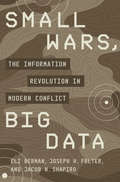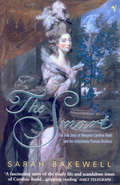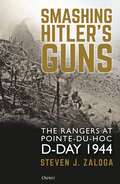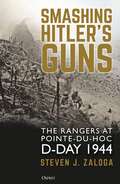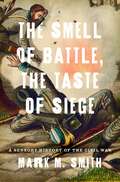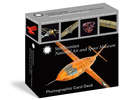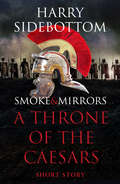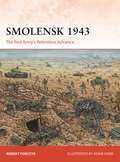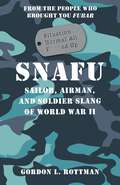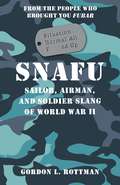- Table View
- List View
Small-Scale Armour Modelling (Modelling Masterclass Ser.)
by Alex ClarkSince the mid-1990s, small-scale armour modelling has seen a great resurgence in popularity, mostly due to model manufacturers in Germany and the many smaller companies that have started selling add-ons and accessories. Using a highly visual, step-by-step approach, this book covers all of the major aspects of small-scale armour modeling, including construction, painting, finishing and presentation. Covering World War II armour, modern vehicles and everything in-between, this book is the ultimate guide for those who appreciate the beauty and craftsmanship of small-scale armour models.
Small-Scale Armour Modelling (Modelling Masterclass Ser.)
by Alex ClarkSince the mid-1990s, small-scale armour modelling has seen a great resurgence in popularity, mostly due to model manufacturers in Germany and the many smaller companies that have started selling add-ons and accessories. Using a highly visual, step-by-step approach, this book covers all of the major aspects of small-scale armour modeling, including construction, painting, finishing and presentation. Covering World War II armour, modern vehicles and everything in-between, this book is the ultimate guide for those who appreciate the beauty and craftsmanship of small-scale armour models.
Small Wars, Big Data: The Information Revolution in Modern Conflict
by Eli Berman Joseph H. Felter Jacob Shapiro Vestal McIntyreHow a new understanding of warfare can help the military fight today’s conflicts more effectivelyThe way wars are fought has changed starkly over the past sixty years. International military campaigns used to play out between large armies at central fronts. Today's conflicts find major powers facing rebel insurgencies that deploy elusive methods, from improvised explosives to terrorist attacks. Small Wars, Big Data presents a transformative understanding of these contemporary confrontations and how they should be fought. The authors show that a revolution in the study of conflict--enabled by vast data, rich qualitative evidence, and modern methods—yields new insights into terrorism, civil wars, and foreign interventions. Modern warfare is not about struggles over territory but over people; civilians—and the information they might choose to provide—can turn the tide at critical junctures.The authors draw practical lessons from the past two decades of conflict in locations ranging from Latin America and the Middle East to Central and Southeast Asia. Building an information-centric understanding of insurgencies, the authors examine the relationships between rebels, the government, and civilians. This approach serves as a springboard for exploring other aspects of modern conflict, including the suppression of rebel activity, the role of mobile communications networks, the links between aid and violence, and why conventional military methods might provide short-term success but undermine lasting peace. Ultimately the authors show how the stronger side can almost always win the villages, but why that does not guarantee winning the war. Small Wars, Big Data provides groundbreaking perspectives for how small wars can be better strategized and favorably won to the benefit of the local population.
Small Wars, Big Data: The Information Revolution in Modern Conflict
by Eli Berman Joseph H. Felter Jacob Shapiro Vestal McIntyreHow a new understanding of warfare can help the military fight today’s conflicts more effectivelyThe way wars are fought has changed starkly over the past sixty years. International military campaigns used to play out between large armies at central fronts. Today's conflicts find major powers facing rebel insurgencies that deploy elusive methods, from improvised explosives to terrorist attacks. Small Wars, Big Data presents a transformative understanding of these contemporary confrontations and how they should be fought. The authors show that a revolution in the study of conflict--enabled by vast data, rich qualitative evidence, and modern methods—yields new insights into terrorism, civil wars, and foreign interventions. Modern warfare is not about struggles over territory but over people; civilians—and the information they might choose to provide—can turn the tide at critical junctures.The authors draw practical lessons from the past two decades of conflict in locations ranging from Latin America and the Middle East to Central and Southeast Asia. Building an information-centric understanding of insurgencies, the authors examine the relationships between rebels, the government, and civilians. This approach serves as a springboard for exploring other aspects of modern conflict, including the suppression of rebel activity, the role of mobile communications networks, the links between aid and violence, and why conventional military methods might provide short-term success but undermine lasting peace. Ultimately the authors show how the stronger side can almost always win the villages, but why that does not guarantee winning the war. Small Wars, Big Data provides groundbreaking perspectives for how small wars can be better strategized and favorably won to the benefit of the local population.
The Smart: The True Story Of Margaret Caroline Rudd And The Unfortunate Perreau Brothers
by Sarah BakewellThe Smart is a true drama of eighteenth-century life with a mercurial, mysterious heroine. Caroline is a young Irishwoman who runs off to marry a soldier, comes to London and slides into a glamorous life as a high-class prostitute, a great risk-taker, possessing a mesmerising appeal. In the early 1770s, she becomes involved with the intriguing Perreau twins, identical in looks but opposite in character, one a sober merchant, the other a raffish gambler. They begin forging bonds, living in increasing luxury until everything collapses like a house of cards - and forgery is a capital offence. A brilliantly researched and marvellously evocative history, The Smart is full of the life of London streets and shots through with enduring themes - sex, money, death and fame. It bridges the gap between aristocracy and underworld as eighteenth-century society is drawn into the most scandalous financial sting of the age.
Smart Grid Security: An End-to-End View of Security in the New Electrical Grid
by Gilbert N. Sorebo Michael C. EcholsThe Smart Grid has the potential to revolutionize electricity delivery systems, and the security of its infrastructure is a vital concern not only for cyber-security practitioners, engineers, policy makers, and utility executives, but also for the media and consumers. Smart Grid Security: An End-to-End View of Security in the New Electrical Grid ex
Smashing Hitler's Guns: The Rangers at Pointe-du-Hoc, D-Day 1944
by Steven J. ZalogaWritten by one of the world's leading experts on D-Day, Smashing Hitler's Guns is a ground-breaking new history of the legendary Rangers' attack on Pointe-du-Hoc.The Ranger attack on the German gun batteries at Pointe-du-Hoc in the early morning hours of D-Day is the stuff of legend. The gun batteries were strategically positioned between the two American D-Day landing beaches, and were considered the main threat to the Operation Neptune landings. In spite of the confusion and chaos of the June 6, 1944 mission, the Rangers succeeded in scaling the 100-foot cliffs, but the guns were nowhere to be found. Spreading out in all directions, a Ranger team managed to find and spike the guns at their hidden location south of Pointe-du-Hoc. For two days, this small force fought off repeated German attacks, until an American relief force finally arrived on 8 June, by which time more than half the Rangers were casualties. The heroic Ranger mission at Pointe-du-Hoc has indeed become a sacred legend, and as a result there are many unexplored controversies. This new book on this famous raid takes a fresh and comprehensive look at the attack on Pointe-du-Hoc, examining the creation of the German gun battery, the initial Allied intelligence assessments of the threat, and the early plans to assault the site. The forgotten Allied bombing attacks on Pointe-du-Hoc are detailed, as well as the subsequent Allied intelligence investigations of the results. While most accounts of Pointe-du-Hoc are based on the published US Army history, the author has tracked down the long-forgotten original, unedited report in the archives that contains a number of curious changes from the better-known and widely accepted version. Little-known interviews of the Rangers who took part in the mission also shed fresh light and a significant number of German records provide the enemy perspective of the battle for control of the guns.
Smashing Hitler's Guns: The Rangers at Pointe-du-Hoc, D-Day 1944
by Steven J. ZalogaWritten by one of the world's leading experts on D-Day, Smashing Hitler's Guns is a ground-breaking new history of the legendary Rangers' attack on Pointe-du-Hoc.The Ranger attack on the German gun batteries at Pointe-du-Hoc in the early morning hours of D-Day is the stuff of legend. The gun batteries were strategically positioned between the two American D-Day landing beaches, and were considered the main threat to the Operation Neptune landings. In spite of the confusion and chaos of the June 6, 1944 mission, the Rangers succeeded in scaling the 100-foot cliffs, but the guns were nowhere to be found. Spreading out in all directions, a Ranger team managed to find and spike the guns at their hidden location south of Pointe-du-Hoc. For two days, this small force fought off repeated German attacks, until an American relief force finally arrived on 8 June, by which time more than half the Rangers were casualties. The heroic Ranger mission at Pointe-du-Hoc has indeed become a sacred legend, and as a result there are many unexplored controversies. This new book on this famous raid takes a fresh and comprehensive look at the attack on Pointe-du-Hoc, examining the creation of the German gun battery, the initial Allied intelligence assessments of the threat, and the early plans to assault the site. The forgotten Allied bombing attacks on Pointe-du-Hoc are detailed, as well as the subsequent Allied intelligence investigations of the results. While most accounts of Pointe-du-Hoc are based on the published US Army history, the author has tracked down the long-forgotten original, unedited report in the archives that contains a number of curious changes from the better-known and widely accepted version. Little-known interviews of the Rangers who took part in the mission also shed fresh light and a significant number of German records provide the enemy perspective of the battle for control of the guns.
The Smell of Battle, the Taste of Siege: A Sensory History of the Civil War
by Mark M. SmithHistorical accounts of major events have almost always relied upon what those who were there witnessed. Nowhere is this truer than in the nerve-shattering chaos of warfare, where sight seems to confer objective truth and acts as the basis of reconstruction. In The Smell of Battle, the Taste of Siege, historian Mark M. Smith considers how all five senses, including sight, shaped the experience of the Civil War and thus its memory, exploring its full sensory impact on everyone from the soldiers on the field to the civilians waiting at home. From the eardrum-shattering barrage of shells announcing the outbreak of war at Fort Sumter; to the stench produced by the corpses lying in the mid-summer sun at Gettysburg; to the siege of Vicksburg, once a center of Southern culinary aesthetics and starved into submission, Smith recreates how Civil War was felt and lived. Relying on first-hand accounts, Smith focuses on specific senses, one for each event, offering a wholly new perspective. At Bull Run, the similarities between the colors of the Union and Confederate uniforms created concern over what later would be called "friendly fire" and helped decide the outcome of the first major battle, simply because no one was quite sure they could believe their eyes. He evokes what it might have felt like to be in the HL Hunley submarine, in which eight men worked cheek by jowl in near-total darkness in a space 48 inches high, 42 inches wide. Often argued to be the first "total war," the Civil War overwhelmed the senses because of its unprecedented nature and scope, rendering sight less reliable and, Smith shows, forcefully engaging the nonvisual senses. Sherman's March was little less than a full-blown assault on Southern sense and sensibility, leaving nothing untouched and no one unaffected. Unique, compelling, and fascinating, The Smell of Battle, The Taste of Siege, offers readers way to experience the Civil War with fresh eyes.
The Smell of Battle, the Taste of Siege: A Sensory History of the Civil War
by Mark M. SmithHistorical accounts of major events have almost always relied upon what those who were there witnessed. Nowhere is this truer than in the nerve-shattering chaos of warfare, where sight seems to confer objective truth and acts as the basis of reconstruction. In The Smell of Battle, the Taste of Siege, historian Mark M. Smith considers how all five senses, including sight, shaped the experience of the Civil War and thus its memory, exploring its full sensory impact on everyone from the soldiers on the field to the civilians waiting at home. From the eardrum-shattering barrage of shells announcing the outbreak of war at Fort Sumter; to the stench produced by the corpses lying in the mid-summer sun at Gettysburg; to the siege of Vicksburg, once a center of Southern culinary aesthetics and starved into submission, Smith recreates how Civil War was felt and lived. Relying on first-hand accounts, Smith focuses on specific senses, one for each event, offering a wholly new perspective. At Bull Run, the similarities between the colors of the Union and Confederate uniforms created concern over what later would be called "friendly fire" and helped decide the outcome of the first major battle, simply because no one was quite sure they could believe their eyes. He evokes what it might have felt like to be in the HL Hunley submarine, in which eight men worked cheek by jowl in near-total darkness in a space 48 inches high, 42 inches wide. Often argued to be the first "total war," the Civil War overwhelmed the senses because of its unprecedented nature and scope, rendering sight less reliable and, Smith shows, forcefully engaging the nonvisual senses. Sherman's March was little less than a full-blown assault on Southern sense and sensibility, leaving nothing untouched and no one unaffected. Unique, compelling, and fascinating, The Smell of Battle, The Taste of Siege, offers readers way to experience the Civil War with fresh eyes.
Smithsonian National Air and Space Museum Photographic Card Deck: 100 Treasures from the World's Largest Collection of Air and Spacecraft
by Dwight Jon ZimmermanCreated in partnership with the world-renowned Smithsonian National Air and Space Museum, this beautifully packaged, informative card deck captures, in words and stunning photographs, 100 of the museum's most important artifacts. The NASM is the world's largest, most-visited collection of historical aircraft and spacecraft, and commemorate major milestones in flight and space exploration. The 100 treasures in this deck, hand-selected by the curators, include the Spirit of St. Louis, flown by Charles Lindbergh on the first non-stop transatlantic flight; Chuck Yeager's Bell X-1, in which he broke the sound barrier; Buzz Aldrin's space suit, worn during the Apollo 11 mission, and the Space Shuttle Discovery, which flew 39 missions and spent 365 days in space. Each card includes a photograph of the object on the front and a 200-word description plus key data on the back.
Smoke and Mirrors: Q-Ships Against the U-Boats in the First World War
by Deborah LakeThe Q-ship, an ordinary merchant vessel with concealed guns, came into its own during the First World War, when the Royal Navy to trap and destroy German U-boats. Deborah Lake uses a wide range of primary and secondary source material drawn from archives in the UK, Germany and the USA to tell the compelling story of the Q-ships and their U-boat adversaries. The Q-ship operations themselves will be covered by following the careers of the eight men who won the Victoria Cross on Special Service Operations; and by accounts of German U-boat crews being on the receiving end. No book on Q-ships can avoid the Baralong incident in which a Q-ship's crew allegedly executed the survivors of the German submarine U-27, on 19 August 1915. In a subsequent encounter with U-41, more British atrocities were alleged by the only two German survivors. Revealing extracts from the diary of a Royal Marine who served on board the Baralong are reproduced in the book together with other first-hand accounts. With charge and counter-charge, this incident provides a fascinating story.
Smoke & Mirrors (A Short Story) (A Short Story) (A Short Story) (A Short Story): A Throne of the Caesars Story: A Throne Of The Caesars Story
by Harry SidebottomA tense and brilliantly dramatic short story from the bestselling author of the Throne of the Caesars Series.
Smoky the Brave: How A Feisty Yorkshire Terrier Mascot Became A Comrade-in-arms During World War Ii
by Damien LewisThe World's Smallest Dog with the World's Biggest HeartSmoky the Brave is the extraordinary, touching and true story of a heroic dog and her adoptive masters in the jungles of the Pacific War. In February 1944, as Japanese military advances threatened to engulf Australasia, a tiny, four-pound Yorkshire terrier was discovered hiding in a Japanese shell scrape amidst the thick jungles of Papua New Guinea. The GIs who discovered her presumed she had been some kind of Japanese army mascot, but it soon turned out that she understood neither commands rendered in Japanese nor English. A mystery, she was adopted by Corporal William 'Bill' Wynne, an air-crewman with the US 5th Air Force's 26th Photo Reconnaissance Squadron.Living in Bill Wynne's tent, sleeping on a piece of green felt salvaged from a card table,and sharing his rations, Smoky became the de facto mascot of the regiment. She went on to fly numerous photo-recce and air-sea rescue missions, cocooned in a soldier's pack hanging next to the machine-guns used to repel marauding Japanese fighters. She was awarded eight battle stars, surviving dozens of Japanese combat raids on Papua New Guinea, and braving a typhoon that ravaged Okinawa. After saving Wynne's life by warning of a falling shell, as their landing craft approached an enemy-held beach - a shell that killed the eight men that Wynne was standing beside - he nicknamed her the 'angel from a foxhole'. In one of her most famous exploits Smoky parachuted using a special rig designed to fit one of the world's smallest but toughest dogs.In perhaps her most heroic exploit of all, Smoky ran a cable through a seventy-foot pipe no wider in places than four inches, to enable telephone lines to be run across the recently occupied airbase of Luzon. Her efforts saved hundreds of ground-crew from being exposed to enemy bombing, preventing injury and loss of life. Amongst her many other awards,she was given the PDSA's Certificate for Animal Bravery or Devotion in 2011, a relatively new class of PDSA award.
Smolensk 1943: The Red Army's Relentless Advance (Campaign #331)
by Robert ForczykWith the German defeat at Kursk, the Soviet Stavka (high command) ordered the Western and Kalinin Fronts to launch Operation Suvorov in order to liberate the city of Smolensk. The Germans had held this city for two years and Heeresgruppe Mitte's (Army Group Centre) 4. Armee had heavily fortified the region. The Soviet offensive began in August 1943 and they quickly realized that the German defences were exceedingly tough and that the Western Front had not prepared adequately for an extended offensive. Consequently, the Soviets were forced to pause their offensive after only two weeks, in order to replenish their combat forces and then begin again. The German 4. Armee was commanded by Generaloberst Gotthard Heinrici, one of the Wehrmacht's top defensive experts. Although badly outnumbered, Heinrici's army gamely held off two Soviet fronts for seven weeks. Eventually, the 4. Armee's front was finally broken and Smolensk was liberated on 25 September 1943. However, the Western Front was too exhausted to pursue Heinrici's defeated army, which retreated to the fortified cities of Vitebsk, Orsha and Mogilev; the 4. Armee would hold these cities until the destruction of Army Group Centre in June 1944. Operation Suvorov focuses on a major offensive that is virtually unknown in the West and which set the stage for the decisive defeat of Heeresgruppe Mitte in the next summer offensive.
Smolensk 1943: The Red Army's Relentless Advance (Campaign)
by Robert Forczyk Adam Hook Bounford.com Bounford.com Paul KimeWith the German defeat at Kursk, the Soviet Stavka (high command) ordered the Western and Kalinin Fronts to launch Operation Suvorov in order to liberate the city of Smolensk. The Germans had held this city for two years and Heeresgruppe Mitte's (Army Group Centre) 4. Armee had heavily fortified the region. The Soviet offensive began in August 1943 and they quickly realized that the German defences were exceedingly tough and that the Western Front had not prepared adequately for an extended offensive. Consequently, the Soviets were forced to pause their offensive after only two weeks, in order to replenish their combat forces and then begin again. The German 4. Armee was commanded by Generaloberst Gotthard Heinrici, one of the Wehrmacht's top defensive experts. Although badly outnumbered, Heinrici's army gamely held off two Soviet fronts for seven weeks. Eventually, the 4. Armee's front was finally broken and Smolensk was liberated on 25 September 1943. However, the Western Front was too exhausted to pursue Heinrici's defeated army, which retreated to the fortified cities of Vitebsk, Orsha and Mogilev; the 4. Armee would hold these cities until the destruction of Army Group Centre in June 1944. Operation Suvorov focuses on a major offensive that is virtually unknown in the West and which set the stage for the decisive defeat of Heeresgruppe Mitte in the next summer offensive.
The Smuggler’s Wife (The\smuggler's Daughters Ser. #3)
by Evie GraceThe brand new novel from bestselling author Evie Grace, set amongst the Napoleonic Wars in the 1800s. Perfect for fans of Dilly Court and Poldark. _______________________KENT 1815 Her heart led her to him, but will loyalty be enough to make her stay . . .When the beautiful but naïve Grace Lennicker falls for Isaiah Feasey, son of a rival smuggling family and owner of a local tavern, her sisters try to intervene. But as tensions grow, there is another suitor also hoping to win her hand in marriage, the dashing and more favourable Albert Enderby, a young lieutenant in the Revenue.Grace is unwittingly drawn back into the world of smuggling that her sisters fought hard to leave behind, and as violence erupts, she finds herself unable to stand by, knowing the rival gangs will kill anyone who stands in their way. When her husband becomes involved, Grace is forced to make a difficult decision - turn him in and risk her life, or stay loyal and risk the lives of those she loves . . .Praise for Evie Grace'Intriguing' Val Wood'A charming historical read that hits all the right notes' Woman's Weekly'Heart-tugging saga of which Catherine Cookson would've approved' Peterborough Evening Telegraph
SNAFU Situation Normal All F***ed Up: Sailor, Airman, and Soldier Slang of World War II (General Military Ser.)
by Gordon L. RottmanMilitary life has always been ruled by its own language, specific sets of terms and phrases that separate the serving man or woman from their civilian counterpart. There is the official version of ranks and acronyms, and the more unofficial, colloquial language of the barrack room and battlefield. This new title explores the language and slang of the major combatant powers, delving into their origins and explaining their uses. All of this will be illustrated with contemporary cartoons and other images showing the phrases in use. This title is designed specifically as a follow-up to 2007's FUBAR: Soldier Slang of World War II, and will differ from the original book in that it will cover the slang of sailors and airman, as well as soldiers. Detailed sections will be included for each of the major combatants of World War II, and additional appendices will detail the nicknames given to the major surface vessels and aircraft types of the war.
SNAFU Situation Normal All F***ed Up: Sailor, Airman, and Soldier Slang of World War II
by Gordon L. RottmanMilitary life has always been ruled by its own language, specific sets of terms and phrases that separate the serving man or woman from their civilian counterpart. There is the official version of ranks and acronyms, and the more unofficial, colloquial language of the barrack room and battlefield. This new title explores the language and slang of the major combatant powers, delving into their origins and explaining their uses. All of this will be illustrated with contemporary cartoons and other images showing the phrases in use. This title is designed specifically as a follow-up to 2007's FUBAR: Soldier Slang of World War II, and will differ from the original book in that it will cover the slang of sailors and airman, as well as soldiers. Detailed sections will be included for each of the major combatants of World War II, and additional appendices will detail the nicknames given to the major surface vessels and aircraft types of the war.
Snake Dance: Journeys Beneath a Nuclear Sky
by Patrick MarnhamThe terrifying first use of nuclear weapons over Hiroshima and Nagasaki in August 1945 was the most controversial act of warfare in history, dramatically ending the Second World War but ushering in the age of mass destruction. Yet it was also the climax of a story that extends beyond Japan and Washington: the culmination of decades of scientific achievement and centuries of colonial exploitation. Snake Dance is the account of a journey that turned into a quest to discover how humanity reaches this point. Patrick Marnham travels from the opulent nineteenth-century palaces of King Leopold II of Belgium, built with riches plundered from the Congo, to the lethally derelict nuclear reactor of modern-day Kinshasa. He follows the shipment of Congolese uranium to the deserts of New Mexico for the Manhattan Project’s secret test detonation. Here he uncovers the legacies of Robert Oppenheimer and Aby Warburg, two ‘mad geniuses’ who confronted the devastating power of twentieth-century science in very different ways. Both men travelled to New Mexico. Oppenheimer was honoured for buiding a bomb, the ancestor of weapons that have enslaved humanity. Warburg, condemned to obscurity and confined to a mental hospital, regained his sanity by studying the rituals of the Native Americans of the Southwest who, for thousands of years, practiced the ritual of the 'snake dance' in an attempt to harness the power of lightening. And it was in New Mexico, at Los Alamos, that the ultimate act of playing God was realised.The circle is closed in Japan.. Faced with the catastrophe at the Fukushima Nuclear Plant in March 2011, scientific man, like the snake dancers, is faced with a power beyond his control. Spanning three continents and the history of civilisation, Snake Dance is at once an intrepid intellectual adventure and a wake-up call for mankind.
Snapdragon: The World War II Exploits of Darby's Ranger and Combat Photographer Phil Stern
by Liesl Bradner Phil SternPrior to Phil Stern's death on December 13, 2014, his original, unfinished, tattered wartime memoir was discovered, stashed away in an old folio box in his cluttered Hollywood bungalow. Best remembered for his iconic images of James Dean, Marilyn Monroe, and JFK's inauguration, his remarkable service during World War II as a combat photographer with Darby's Rangers has remained largely unknown. Until now.Stern's catchy 1940s lingo, honest and intimate observations, and humor, paired with his striking combat photography, transport the reader 70 years back in time to meet the hardscrabble Rangers and experience some of the key battles of the Mediterranean Theater. Snapdragon is an artifact of that time, told not by a man reminiscing in his twilight years, but by a young soldier fresh from the battlefields.
Snapdragon: The World War II Exploits of Darby's Ranger and Combat Photographer Phil Stern
by Liesl Bradner Phil SternPrior to Phil Stern's death on December 13, 2014, his original, unfinished, tattered wartime memoir was discovered, stashed away in an old folio box in his cluttered Hollywood bungalow. Best remembered for his iconic images of James Dean, Marilyn Monroe, and JFK's inauguration, his remarkable service during World War II as a combat photographer with Darby's Rangers has remained largely unknown. Until now.Stern's catchy 1940s lingo, honest and intimate observations, and humor, paired with his striking combat photography, transport the reader 70 years back in time to meet the hardscrabble Rangers and experience some of the key battles of the Mediterranean Theater. Snapdragon is an artifact of that time, told not by a man reminiscing in his twilight years, but by a young soldier fresh from the battlefields.
Sniper: A History of the US Marksman (General Military Ser.)
by Martin Pegler Chuck MawhinneyFollowing the success of Out of Nowhere: A History of the Military Sniper, sniper expert Martin Pegler gives us an in-depth study of the emergence of American rifleman, sharpshooter and sniper, examining the evolution of the rifle in America from the earliest firearms of the 15th century to the highly accurate sniping rifles of the 21st century. Pegler analyses the technological development of the rifle, sighting systems and ammunition and uses contemporary accounts to describe how the use of the rifle during the Revolutionary War, Civil War and the conflicts of the 20th and 21st centuries have impacted on US military history. This detailed account concludes with a study of the American sniper in modern warfare, including Afghanistan and the ongoing conflict in Iraq, providing an overview of the march of weapons technology, as well as an unusual insight into the lives and the motives of the men who used them.
Sniper: A History of the US Marksman
by Martin Pegler Chuck MawhinneyFollowing the success of Out of Nowhere: A History of the Military Sniper, sniper expert Martin Pegler gives us an in-depth study of the emergence of American rifleman, sharpshooter and sniper, examining the evolution of the rifle in America from the earliest firearms of the 15th century to the highly accurate sniping rifles of the 21st century. Pegler analyses the technological development of the rifle, sighting systems and ammunition and uses contemporary accounts to describe how the use of the rifle during the Revolutionary War, Civil War and the conflicts of the 20th and 21st centuries have impacted on US military history. This detailed account concludes with a study of the American sniper in modern warfare, including Afghanistan and the ongoing conflict in Iraq, providing an overview of the march of weapons technology, as well as an unusual insight into the lives and the motives of the men who used them.
Sniper Fire in Belfast (SAS Operation)
by Shaun ClarkeUltimate soldier. Ultimate mission. But can the SAS survive working deep undercover among the terrorists of Northern Ireland?


